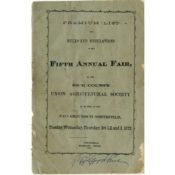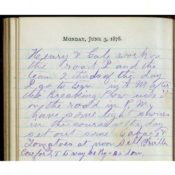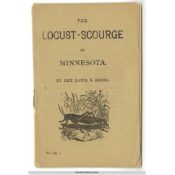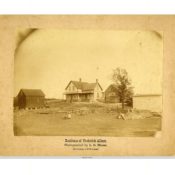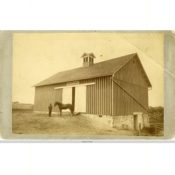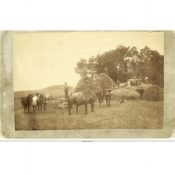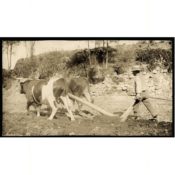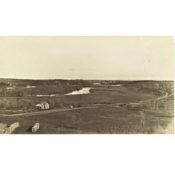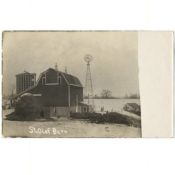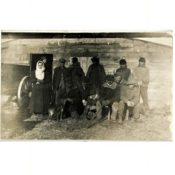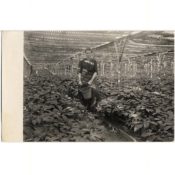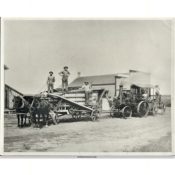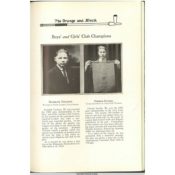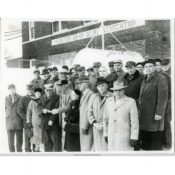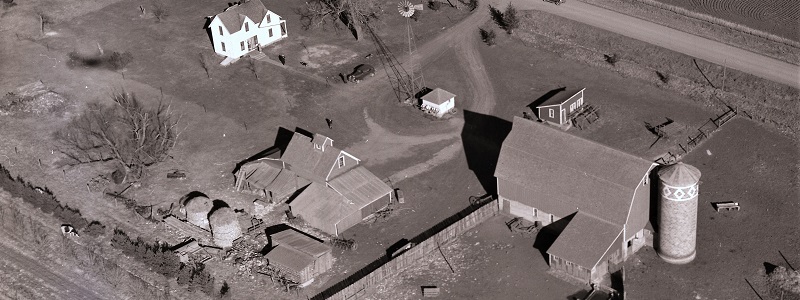
By Stephanie Hess, Northfield-Rice County Digital History Collection, January 2019
Northfield has always been a town surrounded by agricultural areas. Farmers in those areas had a relationship with the town of Northfield based on supply and demand.
Most settlers came to the Northfield area in the 1850s to break the ground and grow crops to survive. By 1860, there were about 800 farms in Rice County. Many farmers started to grow wheat in addition to food for their families. They produced more wheat than they needed and sold it as flour to bring cash income to their farms.
In the 1870s, most of the farms in the area grew wheat. Other farms also grew small grains like hay, oats, and flax. During this period, farmers in the area harvested over half a million bushels of wheat. These bushels went directly to area mills to be ground into flour.
In 1878, the wheat crop was affected by a blight disease. The stalks of wheat were covered by a black rust that ruined the harvest in much of the state. Farmers continued to plant some wheat but began to explore other farming options, such as barley or livestock.
By the 1880s Northfield-area farmers began to replace wheat with dairy farming. Local farmer and newspaper editor William F. Schilling believed that Northfield could become a cattle-buying destination if farmers raised only one kind of cow—the Holstein. He purchased a dairy farm and a Holstein herd and urged the community to do the same.
Eventually the town had nearly 300 herds of almost 4,000 valuable purebred cows. That was why the local Commercial Club decided in 1914 that the town’s slogan should be “Cows, Colleges, and Contentment.” But by the 1920s, the dairy industry became less profitable due to new laws, high costs, high taxes, and even new technologies that made growing grain easier again.
The Northfield area’s agriculture directly affected the town’s industry. Farmers needed nearby mills to process their cash crop of wheat. Mills like Northfield’s Ames Mill served this need. Later, they needed places to process and market the milk their Holsteins produced. Northfield had several milk factories, called creameries, from the 1880s through the 1960s.
Townspeople and rural families depended on each other for economic reasons as well as social reasons. Farmers produced raw goods for the town’s industry, and the town provided services and equipment for farming. Farm families came into town for their mail, the news, shopping, and visiting with friends.
In the 20th century, farming began to change. Steam and gasoline-powered machines slowly began replacing horses and oxen. Electricity brought better heating, refrigeration, appliances, and more—improving the quality of life on farms. The number of farms declined, while the size of farms grew.
Despite these improvements, farms in the Northfield area were affected by worldwide events out of their control. World War I and II provided a high demand for farm goods, but the Great Depression caused the farm economy to collapse. Many farms did not recover. Since then, there have been years of profit and years of loss in the area’s agriculture.
More recently, corn and soybeans have become the main crops of farms in the Northfield area. Farmers also raise hogs and turkeys in addition to dairy cows. Farming has become more of a business than a way of life thanks to mechanization and larger farm sizes.
Ever since the first settlers came to the Northfield area, farming has been a part of the Northfield story. Although there are fewer farms in the area today compared to 100 years ago, it is still an important industry for Northfield.
Primary Sources
Discussion Questions
When you look at the individual items in the Northfield-Rice County Digital History Collection, use the zoom-in tool to view details in the images or more easily read the documents. Use the tab labeled “TEXT” to read full transcriptions of the documents.
Questions
- Why was the Northfield region a good place for agriculture? Think about the physical features and resources of the area.
- What kind of work was needed on farms to succeed before 1900? What about farms from 1900-1950, 1950-2000, and today? Think of ways that each member of a farming family can contribute. Which job would you like doing the most? How have these jobs changed from farming in the past to farming today?
- What kind of factors affected farms negatively? Think about insects, disease, economic issues, wars, etc. Can you see any examples of these in the set above?
- Threshing is a way to remove the edible part of wheat from the wheat plant. Compare and contrast the horse-powered threshing photograph and the steam-powered threshing photograph. What makes these photos similar? What makes them different?
- Look at historic maps of the Northfield region like the 1900 Plat Book and the 1915 Atlas and Farmers’ Directory. Can you identify where the farms were located? Are they in the same places 15 years apart? Are they still there? Do you recognize any of the farm family last names from one map to the next? What do these clues tell you about the people who farmed the area?
- Why did Northfield farmers decide to raise only one kind of cow? What made Holstein cows the right choice? Learn more about these dairy cows in Heatwole’s Dairy Paper and Minnesota Dairyman
- Why do you think schools like St. Olaf College and the International Order of Odd Fellows children’s home had farms and raised cows?
- Look at this aerial photograph of a farm from around 1940. Can you figure out how each building might have been used? What clues can you see in the photo’s details?
- How has technology changed farming? What are the pros and cons of mechanized, modern types of farming?
- Identify the ways agriculture affects other industries in Northfield. How has the relationship changed between the town and its surrounding rural areas? How has it remained the same?
Related Items on the Northfield-Rice County Digital History Collection
Atlas and Farmers’ Directory of Rice County, Minnesota, 1915
Diary of Newton S. Persons, 1878
Kathryn Ripple Schrader Memoir (female perspective on farming life)
Northfield Community Holstein Club Minutes
Northfield Farmers Mercantile & Elevator Company documents
Northfield Sampler “Farming” radio program, broadcast by WCAL Radio in 1979
Plat Book of Rice County, Minnesota, 1900 (includes maps of farms in the Northfield region)
Additional Resources
Lesson Plans and Teacher Guides
American Farm Bureau. My American Farm lesson plans. Web (accessed November 19, 2018).
Discovery Education. Discovering Farming lesson plans. Web (accessed November 19, 2018).
Johns Hopkins Center for a Livable Future. FoodSpan: Teaching the Food System from Farm to Fork. Web (accessed November 19, 2018).
National Agriculture in the Classroom. “Growing a Nation: The Story of American Agriculture.” Web (accessed June 5, 2018).
Additional Resources for Research
Andreas, A. T. “Rice County” and “Dakota County,” in An Illustrated Historical Atlas of the State of Minnesota. Chicago: Chas. Shober & Co., 1874. Available online (accessed June 20, 2018).
Cameron, Linda A. “Agricultural Depression, 1920–1934.” MNopedia, Minnesota Historical Society. Web (accessed June 5, 2018).
Cardwell, Vernon. “Corn Production in Minnesota, 1866–2016.” MNopedia, Minnesota Historical Society. Web (accessed June 5, 2018).
Clark, Clifford E., Jr., ed. Minnesota in a Century of Change: The State and Its People Since 1900. St. Paul: Minnesota Historical Society Press, 1989.
Johnson, Frederick. “King Wheat in Southeastern Minnesota.” MNopedia, Minnesota Historical Society. Web (accessed June 5, 2018).
Kolnick, Jeff. “Land, Labor, the Market, and Politics.” MNopedia, Minnesota Historical Society. Web (accessed June 5, 2018).
Northfield Bicentennial Committee. Continuum: threads in the community fabric of Northfield, Minnesota. Northfield, MN: The City of Northfield, 1976.
Northfield Heritage Preservation Commission. Northfield: The History and Architecture of a Community. Northfield, MN: Northfield Printing, 1999.
Our Story: A Guide to the History of Northfield Minnesota. Northfield, MN: Northfield Historical Society Press, 2013.
Younglove, Erica. “Mechanization of Farming in Minnesota” Primary Source Set, Minnesota Digital Library. Web (accessed August 31, 2018).
Primary Source Analysis
Here are some tips for analyzing the primary sources found above and throughout the DHC. For each source, ask students to indicate:
- the author’s point of view
- the author’s purpose
- historical context
- audience
For inquiry-based learning, ask students to:
- explain how a source tells its story and/or makes its argument
- explain the relationships between sources
- compare and contrast sources in terms of point of view and method
- support conclusions and interpretations with evidence
- identify questions for further investigation
Additional Tools
- Document Analysis Worksheets from the National Archives
- Teaching with Primary Sources Videos and Sets from the Minnesota Historical Society
- Using Primary Sources from the Library of Congress
Minnesota Education Standards
Here is a list of education standard codes for benchmarks that can be explored using this Primary Source Set.
- 0.4.1.2.1
- 1.4.1.2.1, 1.4.1.2.2, 1.4.2.4.1, 1.4.2.4.2
- 2.4.1.2.1
- 3.4.1.2.1
- 4.4.1.2.1
- 5.4.1.2.1
- 6.3.3.6.1, 6.3.4.10.1, 6.4.1.2.1, 6.4.4.18.1, 6.4.4.20.1
- 7.4.1.2.1, 7.4.4.18.2
- 9.4.1.2.1, 9.4.4.18.1, 9.4.4.20.3, 9.4.4.21.2
- 1.8.7.7
- 2.8.7.7
- 3.2.7.7, 3.6.2.2, 3.6.7.7, 3.6.8.8, 3.8.2.2, 3.8.7.7, 3.8.8.8
- 4.2.7.7, 4.6.2.2, 4.6.7.7, 4.6.8.8, 4.8.2.2, 4.8.7.7, 4.8.8.8
- 5.2.7.7, 5.6.2.2, 5.6.7.7, 5.6.8.8, 5.8.2.2, 5.8.7.7, 5.8.8.8
- 6.12.1.1, 6.12.2.2, 6.12.4.4, 6.12.7.7, 6.12.9.9, 6.14.2.2, 6.14.7.7, 6.14.8.8
- 9.12.1.1, 9.12.2.2, 9.12.4.4, 9.12.7.7, 9.12.9.9, 9.14.2.2, 9.14.7.7, 9.14.8.8
- 11.12.1.1, 11.12.2.2, 11.12.4.4, 11.12.7.7, 11.12.9.9, 11.14.2.2, 11.14.7.7, 11.14.8.8
Send us feedback about this primary source set.
This publication was made possible in part by the people of Minnesota through a grant funded by an appropriation to the Minnesota Historical Society from the Minnesota Arts and Cultural Heritage Fund. Any views, findings, opinions, conclusions or recommendations expressed in this publication are those of the authors and do not necessarily represent those of the State of Minnesota, the Minnesota Historical Society, or the Minnesota Historic Resources Advisory Committee.

